
President Donald Trump says he will push ahead with a massive campaign rally in Tulsa, Oklahoma, on Saturday, even as COVID cases are surging there as the state reopens. Trump delayed the rally by one day after it was originally scheduled for June 19, Juneteenth, a celebration marking the emancipation of enslaved people. Tulsa is also the site of one of the deadliest massacres in U.S. history, when a white mob in 1921 killed as many as 300 people in a thriving African American business district. “The rally is troubling to a lot of people because of both the venue, Tulsa, and because of the timing,” says Hannibal B. Johnson, attorney and author of “Black Wall Street: From Riot to Renaissance in Tulsa’s Historic Greenwood District.”
Transcript
AMY GOODMAN: We begin today’s show in Tulsa, Oklahoma, where President Donald Trump will host a massive indoor campaign rally Saturday, despite concerns that the gathering will lead to a surge in COVID-19 cases in a state where the virus is already alarmingly on the rise. The Centers for Disease Control and Prevention reported Oklahoma has seen a 7.7% increase in COVID cases — the largest in the country.
Tulsa’s health director said he wished the president would postpone the rally, the first since the outbreak of the coronavirus in the U.S. in March, due to concerns about the virus. The mayor has also said he doesn’t want it there now. Two Oklahoma lawyers have sued in an attempt to halt the rally, saying the event will endanger the Tulsa community.
Despite public health experts’ warnings against large indoor gatherings, the Trump administration is moving forward with plans to fill the 19,000-seat arena for the rally, with tens of thousands more in the nearby convention center. Vice President Mike Pence, who will attend the rally, falsely claimed that, in a very real sense, Oklahoma had flattened the curve of COVID infections. This is Trump speaking Monday.
PRESIDENT DONALD TRUMP: Oklahoma’s at a very low number. They’ve done really fantastic work. They have a new — a pretty new, magnificent arena, as you probably have heard. And we’re getting exact numbers out, but we’re either close to or over 1 million people wanting to go. We have a 22,000-seat arena, but I think we’re going to also take the convention hall next door, and that’s going to hold 40,000. So we’ll have 22,000 plus 40,000, which would mean that we’d have over 900,000 people that won’t be able to go, but hopefully they’ll be watching.
AMY GOODMAN: The Trump campaign is requiring attendees to his rally to sign a waiver absolving the campaign of liability if an attendee contracts COVID-19, but they are not requiring the attendees to wear masks, in contravention of the CDC.
This comes as President Trump also faces outrage for choosing Tulsa, Oklahoma, as the location of his first rally amidst the nationwide uprising against racism and police brutality. The Trump administration rescheduled the rally to Saturday after originally announcing it would be held this Friday. That’s June 19th, or Juneteenth, a celebration of African Americans’ liberation from slavery.
But Tulsa is also the site of one of the deadliest massacres in U.S. history. In 1921, 99 years ago this month, a white mob attacked a Black neighborhood in Tulsa, killing as many as 300 African Americans. Over two days, white mobs set fire to homes, businesses and churches in Greenwood, a thriving African American business district known at the time as “Black Wall Street.” When the smoke cleared, the area lay in ruins.
This is an excerpt from the History Channel documentary The Night Tulsa Burned, which features some of the survivors who were just children when the attack occurred. This is George Monroe, followed by Juanita Burnett Arnold and Ernestine Alpha Gibbs.
GEORGE MONROE: I will always remember four men coming in our house with torches, and my mother saw them coming, and she put the four of we children under the bed. And from under the bed, we could see them walking to the curtains and setting fire to the curtains to set our house on fire.
JUANITA BURNETT ARNOLD: We start hearing shots. And my grandfather told us all to get up. And we got up, and we could see smoke and hear — hear shots. And we couldn’t sleep or anything. We were just frightened nearly to death.
ERNESTINE ALPHA GIBBS: As soon as daylight came, we looked outside. All of these people were coming down this railroad track. Didn’t nobody try to take a thing. And those people were coming along one track. They just had clothes on. That’s all. They didn’t try to take anything.
AMY GOODMAN: For more, we go to Tulsa, Oklahoma, where we’re joined by Hannibal Johnson, attorney and author of several books about the history of Tulsa’s African American community, including Black Wall Street: From Riot to Renaissance in Tulsa’s Historic Greenwood District, Up from the Ashes and Images of America: Tulsa’s Historic Greenwood District.
So, if you could start, Hannibal Johnson, by talking about what happened 99 years ago this month?
HANNIBAL JOHNSON: What happened in Tulsa in 1921 was really emblematic of the racial violence that pervaded the United States during that period. In fact, historians and sociologists refer to the early part of the 20th century as the nadir of race relations in America, the low point of race relations in America, because of the proliferation of these so-called race riots — mostly invasions of Black communities by vigilante white mobs — and because of the prevalence of lynching, lynching being a form of domestic terrorism targeting primarily African Americans. So this was a period fraught with racial violence and historical racial trauma. The event in Tulsa is the worst of the so-called race riots during this period in terms of its magnitude.
The business community in the Greenwood District, the Black sector in Tulsa, was highly developed — a great concentration of service providers, like doctors, lawyers, pharmacists and dentists, but all manner of business enterprises, small businesses like movie theaters, dance halls, barbershops, restaurants, grocery stores, haberdasheries, shine shops — a real concentration of Black entrepreneurship and Black wealth in a 35-square-block area in Tulsa, Oklahoma, separated from downtown Tulsa by the Frisco tracks.
JUAN GONZÁLEZ: Hannibal Johnson, you mentioned the racial conflicts of that period, which many Americans are not aware of. But there were — throughout the country in the World War I, post-World War I period, there were these huge conflicts. There was the Houston mutiny of 1917 of Black soldiers against racism that they were perceiving in the military. There was the East St. Louis riot of 1917, the Chicago riot of 1919 and the Elaine, Arkansas, massacre, where over a hundred African Americans were massacred in Elaine. Was part of this the result of the fact that as African Americans began being impressed into the military, there was even more willingness, one, on the one hand, of African Americans to stand up for their rights, and also of whites to seek to suppress the African American community?
HANNIBAL JOHNSON: Right. I think it’s important to understand the pervasiveness and the power of white supremacy as a philosophy during this period. So we had these African American men who went off to war in foreign countries, sacrificed their lives, potentially, for the country and for their American citizenship. They come back to the United States, and they’re treated as, at best, second-class citizens; at worst, subhuman. So, Black men were much more vocal about protecting their civil rights after having served in World War I. On the flipside of that, the white community, noticing this new sense of emboldment on the part of African Americans, was determined to enforce white supremacy. And these events, that were called race riots, and these lynchings are really in service of white supremacy.
AMY GOODMAN: It’s very interesting, because we’ve been looking at the bringing down of the Confederate statues around the country and the naming of military bases after Confederates, like Fort Bragg, and this was right around the same time — not during the Civil War, but way after — that they named these bases after Confederate soldiers, again, as they saw the rising empowerment of African Americans, to pull them down. I wanted to go to Tulsa native, professor Olivia Hooker, a survivor of the Greenwood massacre, describing the attack on her community that took place when she was just 6 years old. She was 92 when she did this interview.
OLIVIA HOOKER: I refuse to call it a “riot,” because it was really, you know, whites decided to burn down the homes of 10,000 people. So, that was not a riot. It was planned desecration. … And when the mobs came in, they had those pine, you know, knots all lighted up, and they set things on fire. And my mother refused to run, because she was busy putting water on the house to try to keep it from burning. And so she put the children under the big oak table. You know, they had those great big tables in those days, with little nooks under them. So we were under the table when the mobs came in.
AMY GOODMAN: So, that’s Tulsa native, professor Olivia Hooker, talking about what happened in 1921. And I wanted to ask you, Hannibal Johnson, about President Trump choosing Tulsa. Now, of course, there’s the surge, and we know that COVID-19 hits the African American community much harder than the rest of the community in this country. There’s a surge in Tulsa. Many of the leaders are asking for it not to be held there. And he was going to hold it Friday, Juneteenth, the celebration of the end of slavery, which has outraged so many, that even President Trump was forced to put it off for a day. Kamala Harris, the senator from California, vying for the vice presidency under a President Joe Biden administration, if that were to happen, said, “This isn’ just a wink to white supremacists — he’s throwing them a welcome home party.” Can you respond to this choice of location and the original date?
HANNIBAL JOHNSON: Right. So, the rally is troubling to a lot of people because of both the venue, Tulsa, and because of the timing. So, we’re in the midst of a COVID pandemic. We’re in the midst of a surge here in Tulsa. Bringing thousands of people together in a tight space where it’s not possible to socially distance, where people don’t have to wear masks, those people are going to attend the rally, then they’re going to spill out into the community writ large and pose substantial risk to all of us here. So, that, in and of itself, is a problem.
The other problem with timing is that even though the rally has now been moved to June 20th as opposed to June 19th, it’s still Juneteenth weekend. There still are festivities going on. It’s a celebratory atmosphere of a very significant day in our history, particularly for African Americans. The rally comes two-and-a-half weeks after the 99th anniversary of the 1921 Tulsa race massacre. So, it’s an issue of sensitivity at the very least.
And the other dynamic that’s important to think about is the character of the rally. And we know something about the potential character of the rally based on prior experience with these sorts of rallies, which tend to be raucous. They tend to be exclusive rather than inclusive. They tend to have elements of race and racism as part of the experience. So that troubles a lot of people, because, here in Tulsa, we are working hard on reconciliation, on moving our community closer together as we approach the 100th anniversary of the 1921 Tulsa race massacre. And the rally has the potential to be a disruptor to where we are on the road to reconciliation.
JUAN GONZÁLEZ: I wanted to ask you — of course, the country has been swept for weeks now by protests over police abuse and the murders of African Americans, but the Tulsa police Major Travis Yates recently denied the existence of systemic racism in the police force. He said African Americans probably should be shot more. In a recording, you can hear him say, quote, “All of the research says we’re shooting African Americans about 24% less than we probably ought to be, based on the crimes being committed.” Your response to the police major in your city?
HANNIBAL JOHNSON: Well, he says that remark was taken out of context, but the remark speaks for itself. And it is deeply troubling. It has been rebuked by both the police chief, Wendell Franklin, and the mayor, G.T. Bynum. And it is not reflective of the officers, ranking officers, whom I know and have worked with for many, many, many years. But again, it is deeply troubling. Whatever the context may have been, whatever the intention may have been, it’s deeply problematic to put those words together on a radio show in the midst of all the things that the country is going through and all the things that we’ve gone through here in Tulsa.
AMY GOODMAN: And, of course, you have the situation of the two kids — I don’t even want to say “jaywalking” — 13-year-old Tulsa residents who were brutalized by the police. I mean, the video of these kids, one of them put in the car, and you see the police officer kicking him. They accuse him of jaywalking on a rural road — and one of these kids is 13 years old — that doesn’t have sidewalks. Hannibal Johnson, have they been suspended? Have they been fired? Have they been charged with assault? Meaning the police officers.
HANNIBAL JOHNSON: So, all I know is that the matter is under investigation, as well it should be. On the surface of things, based on the facts that we know, as you just recited them, this is deeply disturbing and troubling. So we need to find the facts, and we need to hold people accountable, as appropriate, based on the facts and circumstances that are determined through the investigatory process.
AMY GOODMAN: Well, Hannibal Johnson, we want to thank you very much for being with us, attorney and author of Black Wall Street: From Riot to Renaissance in Tulsa’s Historic Greenwood District. Final question, 20 seconds: Are people getting reparations for what happened in 1921? Wasn’t there a commission set up that said they should?
HANNIBAL JOHNSON: There was a commission that was convened in 1997, issued a final report in February of 2001. It recommended reparations for riot survivors and descendants of riot survivors who could prove loss of property. There was a lawsuit filed in the early 2000s. It was dismissed on the basis of statute of limitations. So, cash reparations to individuals have not happened. We are looking at reparations in other forms, including building a substantial history center here in the Greenwood District, a pathway to hope that connects various sites in the Greenwood District, and other initiatives that are more community-based rather than individually focused.
AMY GOODMAN: Thank you so much, Hannibal Johnson. We will continue to look at Tulsa on Friday on Democracy Now!, when we’ll be joined by the sister, the twin, of a man who was killed by police in 2016. Her great-grandmother survived the Tulsa race massacre.
This is Democracy Now! When we come back, we go to Puerto Rico. Stay with us.

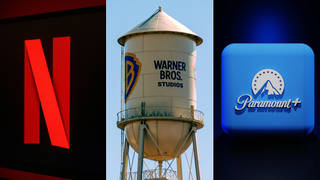
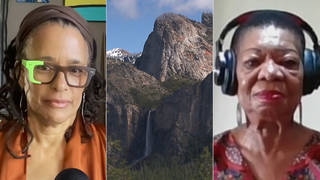
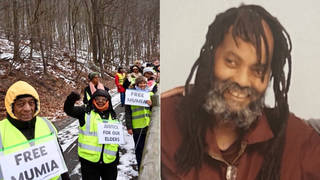
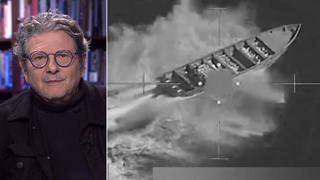





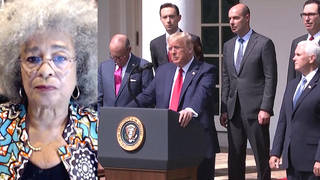

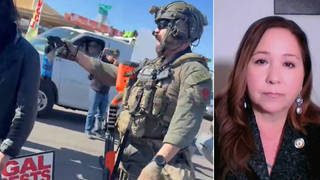
Media Options